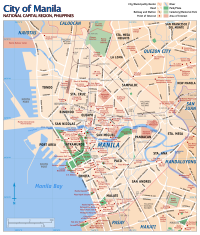Quiapo, Manila
 | |
| City | Manila |
|---|---|
| Population (2000) | 24,615 |
| – Density | |
| Area | km² |
| – Barangays | 16 |
| – Cong. Districts | 3rd District |
Quiapo is a district of Manila, Philippines, also referred to as Manila's downtown. It is known for its cheap prices on items ranging from electronics to native handicrafts.
Quiapo is also famous for the Black Nazarene. Thousands of people parade through the streets to touch the statue where it is supposed to produce miraculous effects. A number of faithful usually collapse in a faint during the ritual, and some have even died. The Feast Day of the Black Nazarene (also known as Quiapo Day) is celebrated every January 9th.
Plaza Miranda is the heart of Quiapo District. It is a square or a public plaza in front of the St. John the Baptist Church or Quiapo Church as it is widely known. It is also a popular site of political rallies. In August 21, 1971, while the Liberal Party held their Miting de Avance in the plaza, a bomb exploded, killing 8 and injuring almost 100 civilians.
The Quiapo district is also home to a sizable Muslim population in Manila, and The Golden Mosque is located there. A veritable army of fortune tellers and stores offering herbal products surround the Quiapo church. The biggest problem underlying the district is piracy and bandits. The largest area where you can buy pirated movies, software and pornographic videos can be found in Quiapo where the stores sprawl over four public streets.
Through the years, the glory of Quiapo steadily declined. During the American period until the late 70s, Quiapo and its surrounding vicinities like Avenida, Binondo, Sta. Cruz, Escolta and the university belt, were the centers of trade, fashion, art, higher learning and the elites of Manila, however as the Light Rail Transit (LRT Line 1) run over the Rizal Avenue, the main thoroughfare of Avenida, dirt and vehicle emissions were trapped underneath, leaving the streets dark and gloomy. The results of this development were the exodus of many establishments and the arrival of ruffians and bandits. After the first EDSA revolution in 1986, the vibrancy of Quiapo diminished, although some flea markets, handicraft stores begin to rise due to the presence of the widely visited Quiapo Church.
In recent years, the local government of Manila, spearheaded by then Mayor Lito Atienza, launched the Buhayin ang Maynila (Revive Manila) project which greatly rehabilitated Quiapo and its vicinities, most specially the Plaza Miranda, the Lacson underpass and the University Belt. Parts of Rizal Avenue, starting from Carriedo St. to Claro M. Recto Avenue were converted into a pedestrian shopping arcade.
Quiapo is geographically located at the very center of the city of Manila. It is bounded by Estero de San Miguel on the South, San Miguel District on the East, Claro M. Recto Avenue on the North and Quezon Boulevard on the West.
Hidalgo Street in Quiapo
Photographers' Haven

Felix R. Hidalgo Street in Quiapo is a hodge podge of knick-knack vendors, covering legitimate business establishments mostly selling photography-related items. For Filipino photographers it has long been the Mecca for photography equipment at, more often than not, lower than market prices. An assortment of accessories from on-camera flashes, studio lights, bags, tripods, lenses, batteries, CDs, DVDs, actually anything photography-related can be found there. In 2006, John Chua, a well-known advertising photographer based in Makati City and Jason B. Lindo, an equally well-known advertising consultant proposed the Hidalgo Project to the Manila City government. The proposal includes the rehabilitation and beautification of Hidalgo Street as a Photographers' Haven. It was very well received and the Mayor immediately appointed government personnel to execute the project, expected to finish before the end of 2006.

Hidalgo St. is intersected by Quezon Boulevard and is connected by the Lacson pedestrian underpass from the new photography haven to the original street that is of historic significance to Quiapo. The street is crowded with jeepneys and pedestrians but leads farther to a showcase of heritage architecture - cluttered through the rest of its humble boundaries.
Heritage Street Project

Hidalgo Street was regarded in the late 19th century as the most beautiful street in Manila. Today, there are proposals to restore and protect the houses on Hidalgo Street from the 19th and early 20th centuries since they create a streetscape that is dignified. However, plans of the Manuel L. Quezon University have not been moving recently and the City Government of Manila has yet to act on the said proposal.
Among the historic structures along Hidalgo Street and its environs are:
- Basilica Minore de San Sebastian
- Basilica Minore of the Black Nazarene (Quiapo Church)
- Ocampo Pagoda (Bilibid Viejo)
- Nakpil-Bautista House (A. Bautista formerly Barbosa), Masterpiece by Arcadio Arellano, Viennese Secession motifs, home of Julio Nakpil, musical composer of the Katipunan, and Gregoria de Jesus, organizer of the women's corps of the Katipunan
- Boix House (beside Nakpil house), Beautiful 1890s house with Neo-Renaissance ornamentation.
- Paterno Mansion (Hidalgo Street), Nobly proportioned mansion with Neoclassic details. Ancestral dwelling of the famous Paterno family.
- Enriquez Mansion (formerly on Hidalgo Street, transferred to Bagac, Bataan), 1890s house with Ionic columns. Praised by Maria Morilla Norton in the 1910s as the "the most beautiful house in the islands." Became the site of the School of Fine Arts of the U.P.
- Ocampo Mansion (Hidalgo Street), Home to Francisco Santiago, composer of the Ave Maria. Original site of the UP Conservatory of Music. Dignified example of early 1900s style.
- Zamora House (Hidalgo Street), Residence of Manuel Zamora, inventor of 'tiki-tiki' for fighting beriberi. Superb sequence of inner courtyards.
- Padilla House (Hidalgo Street)
External links

